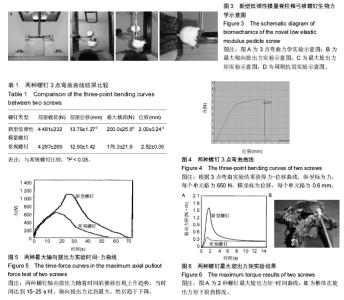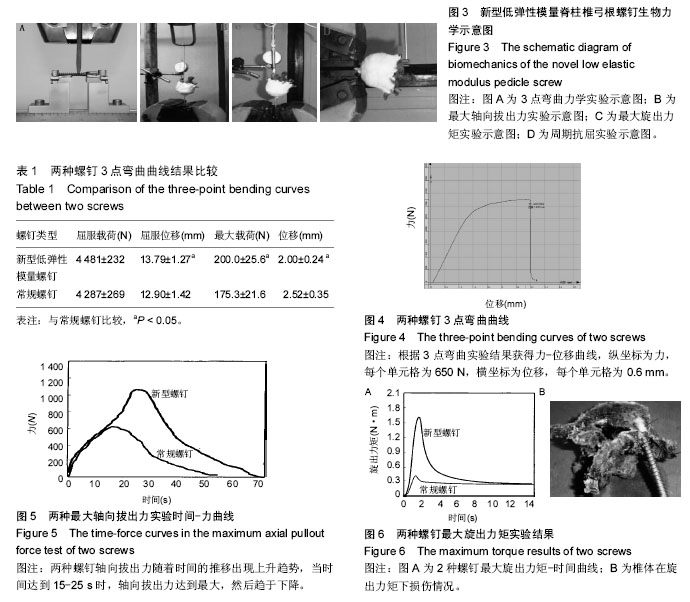Chinese Journal of Tissue Engineering Research ›› 2016, Vol. 20 ›› Issue (53): 7959-7965.doi: 10.3969/j.issn.2095-4344.2016.53.008
Previous Articles Next Articles
Design and biomechanical properties of a novel low elastic modulus spine pedicle screw
Ruan Zhi1, A Lu-ti2
- 1First Affiliated Hospital of Medical College of Shihezi University, Shihezi 832000, Xinjiang Uygur Autonomous Region, China; 2First Affiliated Hospital of Xinjiang Medical University, Urumqi 830054, Xinjiang Uygur Autonomous Region, China
-
Revised:2016-10-12Online:2016-12-23Published:2016-12-23 -
Contact:Ruan Zhi, First Affiliated Hospital of Medical College of Shihezi University, Shihezi 832000, Xinjiang Uygur Autonomous Region, China -
About author:Ruan Zhi, Associate chief physician, Studying for doctorate, First Affiliated Hospital of Medical College of Shihezi University, Shihezi 832000, Xinjiang Uygur Autonomous Region, China -
Supported by:the Natural Science Foundation of Xinjiang Uygur Autonomous Region, No. 2013211A082
CLC Number:
Cite this article
Ruan Zhi, A Lu-ti. Design and biomechanical properties of a novel low elastic modulus spine pedicle screw[J]. Chinese Journal of Tissue Engineering Research, 2016, 20(53): 7959-7965.
share this article

2.1 实验样本数量分析 共6具脊柱标本,共42个椎体全部进行结果分析。 2.2 两种螺钉3点弯曲曲线结果比较 新型低弹性模量螺钉与常规螺钉在屈服载荷上差异无显著性意义(P > 0.05);新型低弹性模量螺钉屈服位移显著大于常规螺钉(P < 0.05),见表1和图4。 2.3 两种最大轴向拔出力实验比较 新型低弹性模量螺钉最大拔出力为(760±178)N,显著大于常规螺钉的(355±87) N (P < 0.05)。从图5可见,两种螺钉轴向拔出力随着时间的推移出现上升趋势,当时间达到15-25 s时,轴向拔出力达到最大,然后趋于下降。 2.4 两种螺钉最大旋出力矩实验结果 新型低弹性模量螺钉最大旋出力矩为(1.347±0.377) N•m,显著大于常规螺钉(0.488±0.205)N•m(P < 0.05)。从图6可见:新型低弹性模量螺钉最大旋出力矩显著大于常规螺钉,但当新型低弹性模量螺钉被突破后将会回落到常规螺钉水平。实验中新型低弹性模量螺钉由于骨水泥的强化而得到增加,但是该最大力矩徒手即可达到,且螺钉旋出后椎体能保持完整。 2.5 两种螺钉周期抗屈实验结果 两种螺钉均完成10次周期抗屈实验,结果显示:新型低弹性模量脊柱椎弓根螺钉最大载荷显著大于常规螺钉(P < 0.05);新型低弹性模量脊柱椎弓根螺钉位移显著低于常规螺钉(P < 0.05),见表1。"

| [1] 李振伟,向阳明.生物力学评价颈椎前路椎弓根螺钉植入骨质疏松椎骨内的稳定性[J].中国组织工程研究,2015, 19(35):5718-5722.[2] 周章彦,朱轶,连福明,等.颈后路椎弓根钉技术治疗寰枢椎创伤性失稳[J].中国医师杂志,2012,14(3):342-343.[3] 林焱斌,林伟,林任,等.改良组合术式治疗复杂胫骨平台骨折的疗效分析[J].中华创伤骨科杂志,2014,16(7): 632-635.[4] Wu AM, Wang XY, Chi YL, et al. Management of acute combination atlas-axis fractures with percutaneous triple anterior screw fixation in elderly patients. Orthop Traumatol Surg Res. 2012;98(8):894-899.[5] 刘伟军,王俊文,黄玉成,等.专家型胫骨髓内钉治疗复杂性胫骨近端骨折[J].中华创伤骨科杂志, 2014,16(3): 265-267.[6] Kato S, Hozumi T, Yamakawa K, et al. META: an MRI-based scoring system differentiating metastatic from osteoporotic vertebral fractures. Spine J. 2015; 15(7):1563-1570.[7] 朱晓文,陈建庭.狄诺塞麦对低骨量妇女腰椎骨密度的影响及其安全性的 meta 分析[J].南方医科大学学报, 2013, 33(6):913-917.[8] 陈作喜,黄义星,黄皆和,等. 颈胸段前路内固定器械的相关 MRI影像解剖学研究[J].温州医学院学报, 2013, 43(11):701-705.[9] 徐彦芳,孙进,周初松,等.全内置式可膨胀型脊柱前路内固定系统研制的解剖学基础[J].实用医学杂志,2013,29(3): 352-354.[10] Chen LX, Li YL, Ning GZ, et al. Comparative efficacy and tolerability of three treatments in old people with osteoporotic vertebral compression fracture: a network meta-analysis and systematic review. PLoS One. 2015; 10(4):123-153.[11] Edidin AA, Ong KL, Lau E, et al. Morbidity and mortality after vertebral fractures: comparison of vertebral augmentation and nonoperative management in the medicare population. Spine (Phila Pa 1976). 2015;40(15):1228-1241.[12] Xiao H, Yang J, Feng X, et al. Comparing complications of vertebroplasty and kyphoplasty for treating osteoporotic vertebral compression fractures: a meta-analysis of the randomized and non-randomized controlled studies. Eur J Orthop Surg Traumatol. 2015;251(53):S77-S85.[13] Zou J, Zhang W, Zhang CQ. Comparison of minimally invasive percutaneous plate osteosynthesis with open reduction and internal fixation for treatment of extra-articular distal tibia fractures. Injury. 2013;44(8): 1102-1106.[14] 高群兴,张盛强,朱干.推拿配合调曲牵引治疗腰椎间盘突出症疗效与腰椎生理曲度的相关性[J].按摩与康复医学, 2014,32(8):35-37.[15] Zou J, Zhang W, Zhang CQ. Comparison of minimally invasive percutaneous plate osteosynthesis with open reduction and internal fixation for treatment of extra-articular distal tibia fractures. Injury. 2013;44(8): 1102-1106.[16] 李伟,张宏,曹丽君,等.脊柱腰段正常及骨质疏松三维有限元数字模型的建立[J].中国组织工程研究, 2013,17(9): 1521-1526.[17] Smorgick Y, Park DK, Baker KC, et al. Single-versus multilevel fusion for single-level degenerative spondylolisthesis and multilevel lumbarstenosis: four-year results of the spine patient outcomes research trial. Spine (Phila Pa 1976). 2013;38(10):797-805.[18] Wong WH. Mild interlaminar decompression for the treatment of lumbarspinal stenosis: procedure description and case series with 1-year follow-up. Clin J Pain. 2012;28(6):534-538.[19] 卫沛然,邹德威,陈晓明,等.后路减压Dynesys动态固定与后路减压融合内固定治疗单节段腰椎退行性疾病的临床疗效的比较[J].颈腰痛杂志,2014,35(2):90-95.[20] 张阳,李放,单建林,等.Dynesys动态内固定与融合术治疗腰椎退变疾病的对比研究[J].脊柱外科杂志,2014,12(1): 19-24.[21] Han Y, Xia Q, Hu YC, et al. Simultaneously Combined Anterior-Posterior Approaches for Subaxial Cervical Circumferential Reconstruction in a Sitting Position. Orthop Surg. 2015;7(4):371-374.[22] Jia Q, Hu L, Yu Y, et al. Balloon vertebroplasty combined with short-segment pedicle screw instrumentation for treatment of thoracolumbar burst fractures. Zhongguo Xiu Fu Chong Jian Wai Ke Za Zhi. 2015;29(6):741-745. [23] Zhai MY, Wang CP, Liu F, et al. The efficacy of pedicle screw instrument in treatment of irreducible atlantoaxial dislocation. Arch Orthop Trauma Surg. 2015;135(9):1193-1199. [24] Sanpera I Jr, Piza-Vallespir G, Burgos-Flores J. Upper thoracic pedicle screws loss of fixation causing spinal cord injury. J Pediatr Orthop. 2014;34(6):e39. [25] Zaryanov AV, Park DK, Khalil JG, et al. Cement augmentation in vertebral burst fractures.Neurosurg Focus. 2014;37(1):E5.[26] Xiu P, Wang Q, Wang G, et al. Morphological and clinical feasibility of C3 pedicle screw instrumentation in patients with congenital C2-3 fusion. Eur Spine J. 2014; 23(8):1730-1736. [27] Ge C, Hao D, He B, et al. Effectiveness of anterior cervical plate fixation for unstable hangman fracture. Zhongguo Xiu Fu Chong Jian Wai Ke Za Zhi. 2014; 28(6):728-732. [28] Hu Y, Xu RM, Albert TJ, et al. Function-preserving reduction and fixation of unstable Jefferson fractures using a C1 posterior limited construct. J Spinal Disord Tech. 2014;27(6):E219-E225.[29] Lü GH, Li J, Wang XB, et al. Surgical treatment based on pedicle screw instrumentation for thoracic or lumbar spinal Langerhans cell histiocytosis complicated with neurologic deficit in children. Spine J. 2014;14(5): 768-776.[30] Skaggs KF, Brasher AE, Johnston CE, et al. Upper thoracic pedicle screw loss of fixation causing spinal cord injury: a review of the literature and multicenter case series. J Pediatr Orthop. 2013;33(1):75-79. [31] Ma C, Wu JB, Zhao M, et al. Treatment of upper cervical spine instability with posterior fusion plus atlantoaxial pedicle screw. Zhonghua Yi Xue Za Zhi. 2011;91(43):3062-3065. [32] Wang SG, Zhao QH, Xie Y, et al. Treatment of combination atlantoaxial fractures with posterior fusion plus atlantoaxial pedicle screw. Zhonghua Yi Xue Za Zhi. 2011;91(31):2172-2175. [33] Deng WX, Zhao HR, Liu H, et al. Treatment of thoracalumbar fractures with pedicle-screw placement on the level of injured vertebrae. Zhongguo Gu Shang. 2011;24(7):541-543.[34] Machino M, Yukawa Y, Ito K, et al. Posterior/anterior combined surgery for thoracolumbar burst fractures--posterior instrumentation with pedicle screws and laminar hooks, anterior decompression and strut grafting. Spinal Cord. 2011;49(4):573-579. [35] Ma W, Xu R, Liu J, et al. Posterior short-segment fixation and fusion in unstable Hangman's fractures. Spine (Phila Pa 1976). 2011;36(7):529-533.[36] Zhao LJ, Xu RM, Ma WH, et al. Evaluation of the value of pedicle screws for cervicothoracic fracture-dislocation. Orthop Surg. 2010;2(1):27-31. [37] Alosh H, Parker SL, McGirt MJ, et al. Preoperative radiographic factors and surgeon experience are associated with cortical breach of C2 pedicle screws. J Spinal Disord Tech. 2010;23(1):9-14. [38] Zhao LJ, Xu RM, Ma WH, et al. Application of the pedicle screws for cervicothoracic fracture-dislocation. Zhongguo Gu Shang. 2009 Aug;22(8):569-572.[39] Gu YJ, Hu Y, Ma WH, et al. Selective treatment of thoracolumbar fracture with posterior monosegmental pedicle screw fixation. Zhongguo Gu Shang. 2009; 22(7): 491-493.[40] Xu LM, Gu R, Lin Y, et al. Clinical study on multi-segmental pedicle screw implantation in the treatment of middle-upper thoracic spine fracture and dislocation. Zhongguo Gu Shang. 2008;21(8):603-605.[41] Fay LY, Wu JC, Tsai TY, et al. Dynamic stabilization for degenerative spond-ylolisthesis: evaluation of radiographic and clinical outcomes. Clin Neurol Neurosurg. 2013;115(5):535-541.[42] 李江龙,刘继波,周鹏,等.Dynesys动态中和系统和经后路椎间融合术治疗腰椎退行性变的疗效比较[J].中国现代医学杂志,2014,24(28):104-107.[43] 姜文涛,梅伟,王庆德,等.椎管减压结合动态稳定系统 Dynesys治疗腰椎退变性疾病[J].中国实用医刊, 2014, 41(14):82-83.[44] Lee KH, Kang DH, Lee CH, et al. Inferolateral entry point for c2 pedicle screw fixation in high cervical lesions. J Korean Neurosurg Soc. 2011;50(4):341-334.[45] 张立军,马正儒,张华杰,等.锁定钢板治疗56例胫骨远端Pillon骨折的临床疗效观察[J].中国医学创新,2013, 10(14):105-106.[46] Yu W, Zhang C, Zhang B, et al. Cytotoxicitic detection of laser welding between NiTi shape memory alloy and stainless steel in vitro. Zhonghua Kou Qiang Yi Xue Za Zhi. 2014;49(4):239-243.[47] Heravi F, Moayed MH, Mokhber N. Effect of fluoride on nickel-titanium and stainless steel orthodontic archwires: an in-vitro study. J Dent (Tehran). 2015; 12(1): 49-59.[48] 邓必权,胡华,滕宇,等.椎弓根螺钉复位内固定后单纯植骨融合与椎间融合器融合治疗腰椎滑脱症的疗效比较[J].中国老年学杂志,2015,35(7):1823-1825.[49] 韩建华,孙厚杰,周鑫,等.腰椎退行性滑脱症内固定与不同植骨融合方式的疗效比较[J].中国矫形外科杂志,2014, 22(13):1226-1230. |
| [1] | Wu Liang-hao, Yu Bao-qing, Chen Fan-cheng. Supercapsular percutaneously-assisted total hip approach for the elderly with femoral neck fractures: study protocol for a prospective, open-label, randomized, controlled clinical trial [J]. Chinese Journal of Tissue Engineering Research, 2017, 21(7): 1009-1014. |
| [2] | Chen Guang-dong, Cao Tong-jun, Li Jian. New bone fixation plate for the repair of avulsion fracture of the tibial attachment of the posterior cruciate ligament: study protocol for a prospective, open-label, self-controlled, clinical trial [J]. Chinese Journal of Tissue Engineering Research, 2017, 21(7): 1020-1024. |
| [3] | Huang Xiang-wang, Liu Hong-zhe. A new low elastic modulus of beta titanium alloy Ti2448 spinal pedicle screw fixation affects thoracic stability: biomechanical analysis [J]. Chinese Journal of Tissue Engineering Research, 2017, 21(7): 1031-1035. |
| [4] | Li Jing, Yang Long, Wang Jian-ji, Liu Qin, Zou Qiang, Sun Yu, Ma Min-xian, Ye Chuan. Three-dimensional reconstruction based on DICOM data and its application for orthopedic implants [J]. Chinese Journal of Tissue Engineering Research, 2017, 21(7): 1046-1051. |
| [5] | Li Hui, Ma Jun-yi, Ma Yuan, Zhu Xu . Establishment of a three-dimensional finite element model of ankylosing spondylitis kyphosis [J]. Chinese Journal of Tissue Engineering Research, 2017, 21(7): 1069-1073. |
| [6] | Qin Di, Shang Yong-wei, Li Hui-jie, Han Yong-tai. Collapsed femoral head measured by X-ray and CT before hip replacement: study protocol for a single-center, open-label and diagnostic trial [J]. Chinese Journal of Tissue Engineering Research, 2017, 21(7): 1080-1085. |
| [7] | Yao Yu, Xue Hua-wei, Zhao Jian, Zhang Feng, Cao Yong, Chen Xiang-dong, Zhao Jin-long, Jiang Xing-jie. Biomechanics of lumbar cortical bone trajectory screw fixation [J]. Chinese Journal of Tissue Engineering Research, 2017, 21(3): 362-366. |
| [8] | Du Shi-yao, Zhou Feng-jin, Ni Bin, Chen Bo, Chen Jin-shui. Finite-element analysis of a novel posterior atlantoaxial restricted non-fusion fixation system [J]. Chinese Journal of Tissue Engineering Research, 2017, 21(3): 383-389. |
| [9] | Liu Jun, Liao Su-ping. Three-dimensional finite element analysis of Kirschner nails and external fixation for Bennett fracture [J]. Chinese Journal of Tissue Engineering Research, 2017, 21(3): 390-395. |
| [10] | Zhang Li-chao, Zhang Li-min, Lv Yong-ming, Wang Zhi-hui, Yang Yang, Xu Fei, Dai Hai-feng, Li Jia, Cao Xiang-yu, Wu Li-zhu. Finite element analysis of knee flexion and extension movement [J]. Chinese Journal of Tissue Engineering Research, 2017, 21(3): 396-400. |
| [11] | Jia Jin-ling, Dong Yu-zhen. Finite element analysis of prosthesis position during hip arthroplasty [J]. Chinese Journal of Tissue Engineering Research, 2017, 21(3): 401-405. |
| [12] | Liu Fu-qian, Liang Wei-guo, Ye Dong-ping. Application and thinking of nucleus replacement, total disc replacement and posterior lumbar dynamic stabilization device for lumbar degenerative diseases [J]. Chinese Journal of Tissue Engineering Research, 2017, 21(3): 440-444. |
| [13] | Wang Jing-xu, Gong Shu-yi, Wu Bo. Efficacy and safety of K-rod dynamic stabilization system in the repair of lumbar degenerative diseases: study protocol for a prospective, self-controlled, clinical trial [J]. Chinese Journal of Tissue Engineering Research, 2017, 21(19): 2980-2985. |
| [14] | Zhou Gang, Zhang Yu-kun, Huang Wei-min. Risk factors for ligamentum flavum hypertrophy in lumbar spinal stenosis patients from the Xinjiang Uygur Autonomous Region, China: protocol for a retrospective, single-center study [J]. Chinese Journal of Tissue Engineering Research, 2017, 21(19): 2993-2998. |
| [15] | Bai Zhao-hui, Zhang Ying, Yin Qing-shui, Xia Hong, Wang Jian-hua, Xu Jun-jie. Navigational template applied in the orthopaedic field in China: a bibliometric analysis [J]. Chinese Journal of Tissue Engineering Research, 2017, 21(19): 3023-3030. |
| Viewed | ||||||
|
Full text |
|
|||||
|
Abstract |
|
|||||